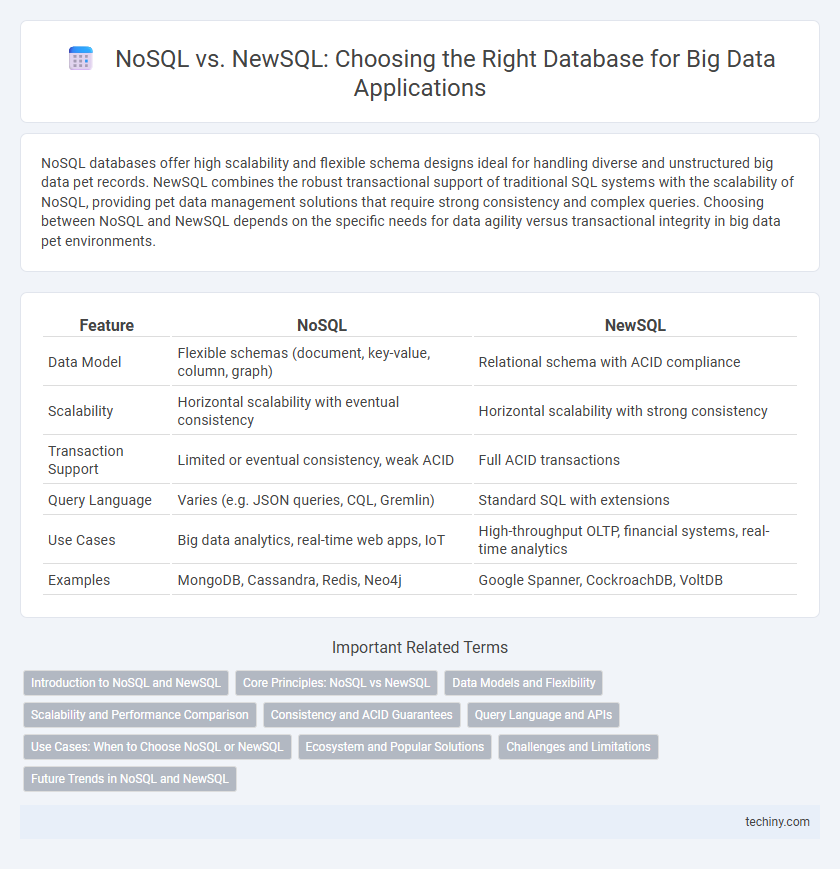NoSQL databases offer high scalability and flexible schema designs ideal for handling diverse and unstructured big data pet records. NewSQL combines the robust transactional support of traditional SQL systems with the scalability of NoSQL, providing pet data management solutions that require strong consistency and complex queries. Choosing between NoSQL and NewSQL depends on the specific needs for data agility versus transactional integrity in big data pet environments.
Table of Comparison
| Feature | NoSQL | NewSQL |
|---|---|---|
| Data Model | Flexible schemas (document, key-value, column, graph) | Relational schema with ACID compliance |
| Scalability | Horizontal scalability with eventual consistency | Horizontal scalability with strong consistency |
| Transaction Support | Limited or eventual consistency, weak ACID | Full ACID transactions |
| Query Language | Varies (e.g. JSON queries, CQL, Gremlin) | Standard SQL with extensions |
| Use Cases | Big data analytics, real-time web apps, IoT | High-throughput OLTP, financial systems, real-time analytics |
| Examples | MongoDB, Cassandra, Redis, Neo4j | Google Spanner, CockroachDB, VoltDB |
Introduction to NoSQL and NewSQL
NoSQL databases provide flexible schema designs and horizontal scalability, making them ideal for handling large volumes of unstructured data in Big Data applications. NewSQL databases combine the scalability of NoSQL systems with the ACID compliance and strong consistency guarantees of traditional relational databases, enabling efficient transactional processing and real-time analytics. Both database types address the limitations of conventional SQL databases, offering tailored solutions for diverse Big Data workloads.
Core Principles: NoSQL vs NewSQL
NoSQL databases prioritize scalability and flexibility by using schema-less data models such as key-value, document, column-family, and graph, enabling high performance for unstructured data across distributed systems. NewSQL databases maintain the ACID (Atomicity, Consistency, Isolation, Durability) properties of traditional SQL systems while optimizing for scalability and high transactional throughput using innovative architectures like distributed consensus and in-memory processing. The core principle of NoSQL centers on horizontal scaling and schema agility, whereas NewSQL emphasizes strong consistency and SQL compatibility combined with modern workload management.
Data Models and Flexibility
NoSQL databases employ flexible data models such as key-value, document, graph, and column-family stores, enabling efficient handling of unstructured and semi-structured data at scale. NewSQL systems combine the ACID compliance and relational schema of traditional SQL databases with improved scalability, offering structured data models optimized for transactional workloads. The choice between NoSQL and NewSQL hinges on the need for schema flexibility versus consistency and relational integrity in big data applications.
Scalability and Performance Comparison
NoSQL databases excel in horizontal scalability by distributing data across multiple nodes, making them ideal for handling massive volumes of unstructured and semi-structured data with low latency. NewSQL databases combine the scalability of NoSQL with the ACID compliance and consistency of traditional SQL systems, delivering high-performance transactional capabilities suitable for complex queries and real-time analytics. In terms of performance, NoSQL offers faster write and read speeds for large-scale, flexible data models, while NewSQL provides enhanced consistency and durability without sacrificing scalability, making it optimal for enterprise-grade applications.
Consistency and ACID Guarantees
NoSQL databases often prioritize availability and partition tolerance over strict consistency, resulting in eventual consistency models that may compromise ACID guarantees. NewSQL systems combine the scalability of NoSQL with the strong ACID compliance and transactional consistency typical of traditional relational databases. This makes NewSQL ideal for applications demanding real-time consistency and integrity in large-scale distributed environments.
Query Language and APIs
NoSQL databases utilize flexible, schema-less query languages and diverse APIs to support a broad range of data models, including document, key-value, column-family, and graph databases, enabling agile development and horizontal scalability. NewSQL systems extend traditional SQL with modern APIs and optimized query engines to handle transactional consistency and high throughput at scale, combining the robustness of relational databases with cloud-native performance. The choice between NoSQL's flexible query paradigms and NewSQL's enhanced SQL compliance hinges on application requirements for consistency, scalability, and operational complexity.
Use Cases: When to Choose NoSQL or NewSQL
NoSQL databases excel in handling unstructured data, supporting flexible schemas, and scaling horizontally for big data analytics, real-time web apps, and IoT devices. NewSQL provides strong ACID compliance and SQL support ideal for transactional systems, financial applications, and enterprise workloads requiring consistency and complex queries. Choosing NoSQL suits dynamic, distributed environments, while NewSQL fits scenarios demanding high consistency with scalable performance.
Ecosystem and Popular Solutions
NoSQL databases dominate the Big Data ecosystem with popular solutions like MongoDB, Cassandra, and Redis, offering flexible schema designs and horizontal scalability for unstructured data. NewSQL systems such as Google Spanner, CockroachDB, and VoltDB combine the scalability of NoSQL with ACID-compliant transactions, addressing the need for consistency in large-scale applications. The evolving ecosystem reflects a shift towards hybrid architectures that leverage the strengths of both NoSQL and NewSQL to optimize performance and reliability in Big Data environments.
Challenges and Limitations
NoSQL databases face challenges such as eventual consistency models that complicate transactional integrity and limited support for complex queries, hindering analytical processing. NewSQL databases address scalability and ACID compliance but often struggle with deployment complexity and lack mature tooling compared to established NoSQL systems. Both paradigms face limitations in balancing horizontal scalability with strong consistency and require careful consideration based on specific workload requirements.
Future Trends in NoSQL and NewSQL
NoSQL databases continue to evolve, emphasizing scalability, flexible schema design, and enhanced support for unstructured data to meet growing Big Data demands. NewSQL databases are advancing to combine traditional relational consistency with the performance and distributed architecture advantages of NoSQL, targeting real-time analytics and transactional workloads. Future trends indicate hybrid approaches leveraging both NoSQL's flexibility and NewSQL's ACID compliance to optimize data management in diverse, large-scale environments.
NoSQL vs NewSQL Infographic

 techiny.com
techiny.com